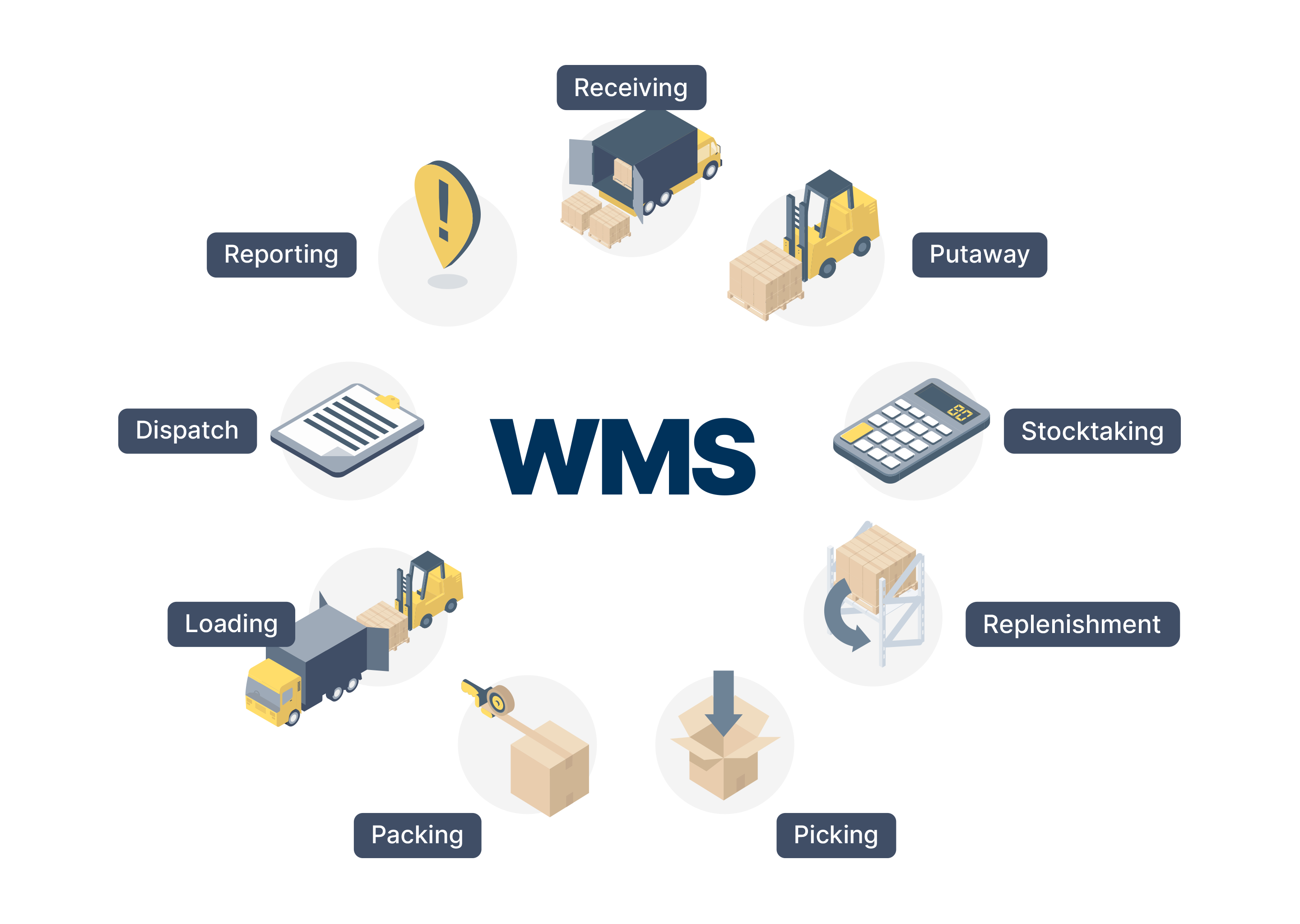- Home
- Knowledge center
- Blog
- What is wms? warehouse management system
Blog
WHAT IS WMS? WAREHOUSE MANAGEMENT SYSTEM
In an increasingly competitive market environment, warehouse operations must be fast, accurate, and flexible. The Warehouse Management System (WMS) allows you to optimize your logistics processes, space, and labor to achieve inventory movement efficiency and accuracy. This blog post will discuss what a WMS is, how it works, and how it can improve customer satisfaction. Let’s get to it!
Need a Fast Overview?
Check Out Our Informative Video
What is a WMS system?
First things first, let’s define the term. WMS means warehouse management system. The acronym is commonly used in the supply chain industry. A WMS is a software designed to optimize and manage warehouse operations.
What does a WMS do?
There are thousands of processes carried out in a warehouse every day. Orders come in, items are picked, boxes are packed, forklifts move along the aisles, and goods are loaded into trucks for delivery. The WMS warehouse management system is a software application designed to create the optimal workflow for your warehouse operations by automating the decision-making logic of these processes. It connects all levels of business logic and machine control and interacts with other warehouse it systems, such as the ERP, WCS, and transport management systems.
As we can see on the image below, the warehouse management system influences all logistics processes in the warehouse.

The WMS is often called the “brain” of the warehouse – just like the human organ, it can learn and adapt to changing needs by combining different systems into one functional entity.
The most common features
Here are the 8 most common features of the warehouse management system:
Inventory management
- keeping correct track of the inventory within the warehouse
- providing real-time visibility into stock levels, locations, and movements of goods
Order management
- prioritizing incoming customer orders based on the frequency
- processing and consolidating orders
- optimizing order workflows
Goods movement
- checking and labeling incoming goods
- selecting the optimal storage location for items based on picking frequency
- forecasting when an article should be replenished based on previous order patterns
Picking & packing
- optimizing pick rounds and routes, creating picklists
- verifying picking accuracy with RFID technology
- selecting the optimal package for shipments based on product dimensions, material, and transportation cost
Value-added services (VAS)
- controlling additional services in the warehouse
- adding value to the article without changing the article number, e.g., shoe impregnation, calibrating tv screens
- adding extra services before shipping goods, e.g., gift wrapping
Outbound goods
- labeling outbound products and creating delivery notes
- organizing shipments according to departure time and fulfillment priority
- maximizing the efficiency of deliveries by automatically recognizing what needs to be loaded first and which shipments should be sent on the same vehicle at the same time
System Integration
- collecting and exchanging data with other systems, e.g., from WMS to a Business Intelligence tool
- integrating with other software such as ERP and TMS
- integrating with warehouse machinery
Reporting
- collecting and presenting various data on warehouse performance, such as inventory levels, order fulfillment, warehouse throughput, and labor efficiency
- giving a clear and visual overview of warehouse operations in real-time to facilitate decision-making and operational improvements
How Does a Modern WMS Work – and What Does It Look Like in Real Life?
Curious about what a WMS actually looks like beyond the buzzwords?
In this short video, you’ll see how Astro WMS® supports real-life warehouse operations – from receiving and picking to real-time optimization and integration with automation.
Astro WMS® helps businesses across industries solve everyday warehouse challenges like labor shortages, space constraints, picking inefficiencies, and high operational costs.
Whether you're managing manual flows, automated systems or both – this is what a future-proof WMS looks like in action.
Real-world results: How our customers use WMS
A system is only as good as the value it creates.
Curious how companies across industries are using WMS to improve accuracy, reduce waste, and scale smarter?
Explore customer success stories
What are the benefits of a WMS?
So, why do companies use WMS, and what are the benefits? Below is the list of the most important aspects:
-
Boosting warehouse efficiency
Every resource you use in the warehouse costs money – be it space, labor, energy, or anything else. A WMS optimizes workflows and lets your warehouse operate in the most efficient way possible, which, in turn, will reduce your operational costs. Efficiency gains can also spike productivity: with a non-reserving system, your operators can work in real-time and combine assignments in the warehouse. You can consolidate your order picking, allowing you to pick multiple orders simultaneously.
-
Securing the scalability and flexibility of your business
In an ever-changing supply chain, your warehouse must be ready for change too. This can be implementing automation, expansion to multiple sites, or having more warehouse staff to meet customer demand. A scalable WMS SaaS solution enables you to
- save all the hassle of building up the IT infrastructure and teams to maintain the system,
- leave the burden of data security and regular system updates to your WMS vendor,
- copy software application and functionalities for multiple sites,
- quickly scale system users according to your needs,
thus, you can run more flexible and future-proof logistics operations.
-
Utilizing your space, the best way
A warehouse’s layout is literally set in stone, so how you use this space makes all the difference. A warehouse management system is a source of valuable information that you can use to optimize the placement of goods. Based on the data it provides, you can remove end-of-life SKUs, and check which products are selling fast and which are slow movers, to adjust their placement accordingly. These actions increase your warehouse throughput while reducing operating costs.
-
Operating smarter with AI
Artificial Intelligence opens new opportunities for efficient and sustainable warehousing. For example, an AI-based pick group optimization module in your WMS can analyze historical ordering patterns. The system can suggest moving articles to a more optimal pick area by learning which articles are ordered together. The more information the WMS has, the more accurate its decisions will be, guaranteeing further improvement to your processes.
-
Saving resources to improve sustainability
A WMS can help you run more resourceful warehouse operations in various ways. For example, it reduces picking errors and prevents you from driving around with empty forklifts. In addition, by using a smart box calculation module, you can ensure that every shipment goes out in the most cost-efficient and least wasteful way possible, cutting down on the amount of air shipped and material used.
-
Providing seamless integration with your other systems
We live in the era of connectivity, and warehouses are no exception. A best-of-breed WMS will give you peace of mind in this area for two reasons:
- No matter how big or small your business ecosystem is, it seamlessly integrates into it. By taking information from your ERP, CRM, or TMS, it generates instructions to facilitate better operational efficiency in the warehouse.
- It supports your warehouse automation efforts. Be it AutoStore, high-bay shuttle, pick robots, you name it - the WMS integrates with all machinery and harmonizes your automated and manual processes.
-
Improving visibility and traceability
Efficiency gains, compliance with regulations, and customer delivery experience are all drivers for improving visibility and traceability throughout the supply chain. By verification/scanning individual articles in warehouse processes, a warehouse management system enables control on the item level. It can also connect the nodes of the delivery chain, so you can notify customers about when their orders are picked and packed, thus improving customer satisfaction.
What are the different types of WMS systems?
The most common WMS types are the following:
- Standalone and best-of-breed WMS
- Available as a module in the ERP
- Available as a module in the supply chain management (SCM) software
- Cloud-based WMS
To decide which type best supports your business, you should have a clear overview of your warehouse needs and goals.
ERP vs. WMS – What’s the Difference?
Many businesses start out managing warehouse operations through their ERP system. But as complexity increases, so does the need for specialization.
An ERP (Enterprise Resource Planning) system manages high-level processes like finance, HR, procurement, and even basic warehouse functions. A WMS (Warehouse Management System), on the other hand, is built to handle the fast-paced, detailed, and real-time execution of warehouse activities.
While the ERP offers an overview, the WMS is the engine that drives day-to-day operational efficiency – from receiving goods to optimizing pick paths and ensuring on-time shipping.👉 Read more: ERP vs. WMS – What’s the Difference?
When do I need the WMS system?
Generally speaking, your WMS journey begins when pen and paper are not enough anymore for efficient warehouse operations. Here are some other signs indicating that you should start looking for a warehouse management system:
- You run out of available warehouse space
- You have inventory discrepancies
- Order fulfillment errors start to rise
- You experience high turnover and shortage of staff
- You receive an increased number of complaints from customers
How do I choose the right WMS system for my needs?
Investing in a warehouse management system is a strategic decision, so the key is thinking long-term and finding a solution that future-proofs your operations. The software should be able to:
- Provide flexible use of functions according to the warehouse setup
- Be scalable in size to adapt to your changing business needs (e.g., multi-site operations)
- Prioritize incoming orders
- Reduce picking errors through the quality pick, pack, ship, and replenish processes
- Support the sustainable use of your resources, e.g., by calculating the most efficient box size for a package
- Seamlessly combine manual and automated processes
- Easily integrate with other systems for making the most effective decisions
- Support advanced order tracking
- Keep a constant, real-time track of your performance
Increasing market competition, growing customer demands, and constant supply chain disruptions put much pressure on warehousing. A modern warehouse management system can help you meet these challenges in the long term.
Are you currently exploring options?
Our WMS warehouse system: Astro WMS® is designed to support your long-term needs: it is scalable, rich in configurable core features and functionality, and adaptable across multiple sites. In addition, it can easily be integrated with any supplier’s automation equipment, giving you the freedom to choose when implementing a warehouse automation solution.
EXPLORE ASTRO WMS®
FAQs about WMS
What is a WMS?
A WMS (Warehouse Management System) is software that helps optimize and automate warehouse operations, such as inventory management, picking, packing, and shipping.
What does WMS stand for?
WMS stands for Warehouse Management System.
How does a WMS improve warehouse efficiency?
A WMS streamlines processes by automating tasks, improving inventory accuracy, optimizing workflows, and reducing errors, leading to faster and more efficient warehouse operations.
What are the key benefits of a WMS?
The main benefits include enhanced inventory visibility, reduced operational costs, improved accuracy in order fulfillment, scalability to meet business growth, and better customer satisfaction.
What are the key features of a WMS?
Core features include real-time inventory tracking, efficient picking and packing processes, order management, system integrations (e.g., ERP or automation systems), and detailed reporting for performance insights.
What types of WMS are there?
-
Standalone and best-of-breed WMS
-
Available as a module in the ERP
-
Available as a module in the supply chain management (SCM) software
-
Cloud-based WMS
Who needs a WMS?
Businesses managing warehouses looking to improve efficiency and support growth. Signs you need one: lack of space, inventory errors, rising order mistakes, staff challenges, or growing customer complaints.
